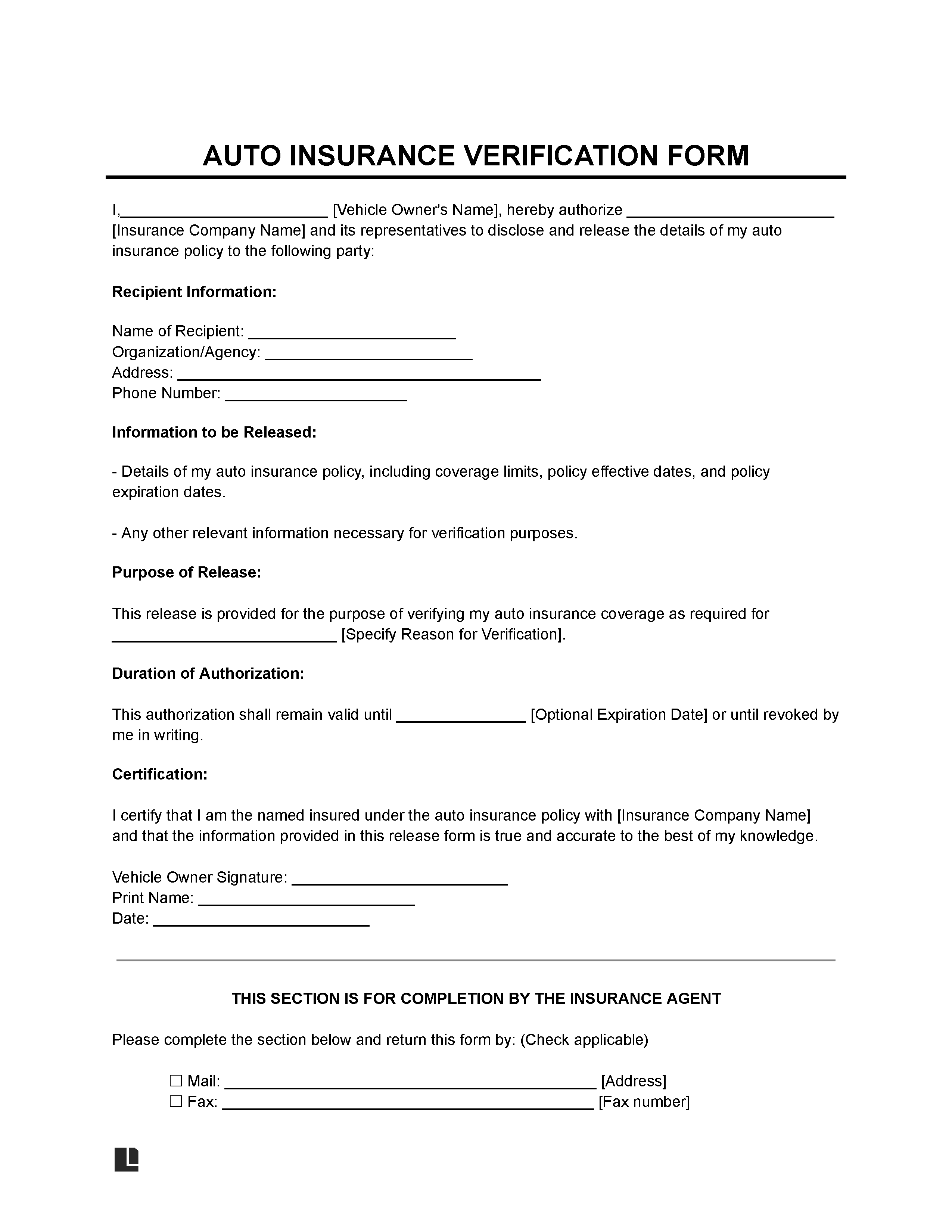What Is an Auto Insurance Verification Letter?
An auto insurance verification letter (or vehicle insurance verification form) is a document that proves a driver has active auto insurance. Rental car companies, DMV offices, employers, and banks often need this form to check that the driver’s insurance is valid. The form includes details like the policy number, expiration date, and coverage limits, making it easy for others to confirm the driver’s insurance status.
After the insurance agent fills out the form, it is sent back to the requester. This helps ensure the driver’s coverage is clear if an accident happens.
When to Verify Auto Insurance
You may need to verify your auto insurance when:
- Leasing or financing a car
- Buying a vehicle
- Working as a commercial driver
- Driving for ride-sharing services
- Reinstating a suspended license
- Borrowing a vehicle
These situations often require proof of active auto insurance, and a verification form can help.
State Requirements for Auto Insurance
Each state has its own auto insurance rules, typically requiring Bodily Injury Liability (BIL) for injuries you cause and Property Damage Liability (PDL) for damage to others’ property.
If you’re asked to provide proof of insurance, the auto insurance verification form confirms your coverage is up-to-date and meets state requirements, making the process easier for you and any third parties, like rental agencies or the DMV.
Minimum Auto Insurance Coverage by State
| State | Requirements |
|---|---|
| Alabama | $25,000 bodily injury liability per person $50,000 bodily injury liability per accident $25,000 property damage liability per accident |
| Alaska | (Car insurance is optional for certain remote residents) $50,000 bodily injury liability per person $100,000 bodily injury liability per accident $25,000 property damage liability per accident |
| Arizona | $25,000 bodily injury liability per person $50,000 bodily injury liability per accident $15,000 property damage liability per accident |
| Arkansas | $25,000 bodily injury liability per person $50,000 bodily injury liability per accident $25,000 property damage liability per accident |
| California | $15,000 bodily injury liability per person $30,000 bodily injury liability per accident $5,000 property damage liability per accident |
Unique State Policies
Some states have special rules for auto insurance:
- New Hampshire: Doesn’t require traditional auto insurance but mandates proof of financial responsibility for at-fault accidents. You can use a financial affidavit to show that you have enough resources to cover potential damages in an accident.
- Virginia: Drivers can opt out of carrying auto insurance by paying a $500 annual “Uninsured Motor Vehicle Fee” to the DMV, but this fee doesn’t provide coverage.
Self Insurance
Self-insurance is setting aside your own money to pay for possible losses, instead of purchasing insurance. The following states accept this type of arrangement instead of third-party insurance:
| States allowing self-insurance | Self-insurance minimum requirements | |
|---|---|---|
| California | $35,000 cash deposit or surety bond. | |
| Connecticut | $50,000 cash or its equivalent for first vehicle, $60,000 for the second vehicle, $65,000 for the third and $70,000 for the fourth. | |
| Florida | $40,000 in unencumbered net worth. | |
| Georgia | $50,000 surety bond or security deposit and $100,000 net worth. | |
| Hawaii | $300,000 surety bond. | |
How to Write an Auto Insurance Verification Letter
If you need to provide proof of auto insurance, follow these simple steps to complete an auto insurance verification letter.
1. Enter Vehicle Owner Information
Fill in the vehicle owner’s name, the recipient’s name, and the purpose of the letter.
2. Provide Recipient Contact Details
Include the recipient’s name, address, and phone number. The insurance agent will then add the following:
- Vehicle owner’s info (name, address, etc.)
- Insurance company details (name, phone, fax)
- Agent’s name and contact info
3. Complete Insurance Information
The agent must answer key questions about the coverage, including:
- Is there liability coverage for third-party injuries or damage?
- Does the coverage protect the insured individual?
- Does it cover rental vehicle damage?
Then, provide the policy number, expiration date, coverage types, and agent’s signature.
4. Submit the Form
Review the form for accuracy, ensuring all signatures and details are correct. Send it via certified mail to guarantee receipt, and keep a copy for your records. Be aware of deadlines to avoid penalties and processing delays.
If you’re buying a vehicle, make sure to also have your Vehicle Bill of Sale and VIN Verification form ready. These documents, along with the auto insurance verification form, are often required for registration and title purposes.
Sample Proof of Car Insurance Letter
Here is a sample proof of car insurance letter, showing the typical sections you’ll need to complete. Once you’re familiar with the format, use our auto insurance verification letter to easily fill it out and download as a PDF or Word document.


